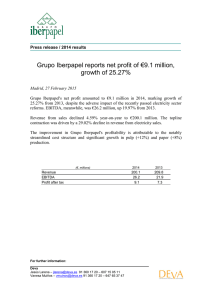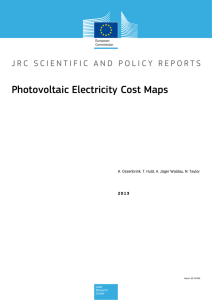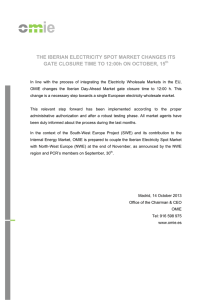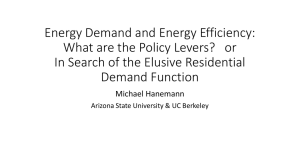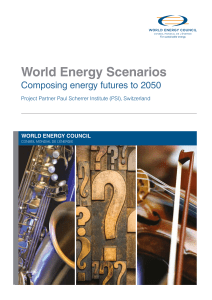Foldout - International Energy Agency
Anuncio
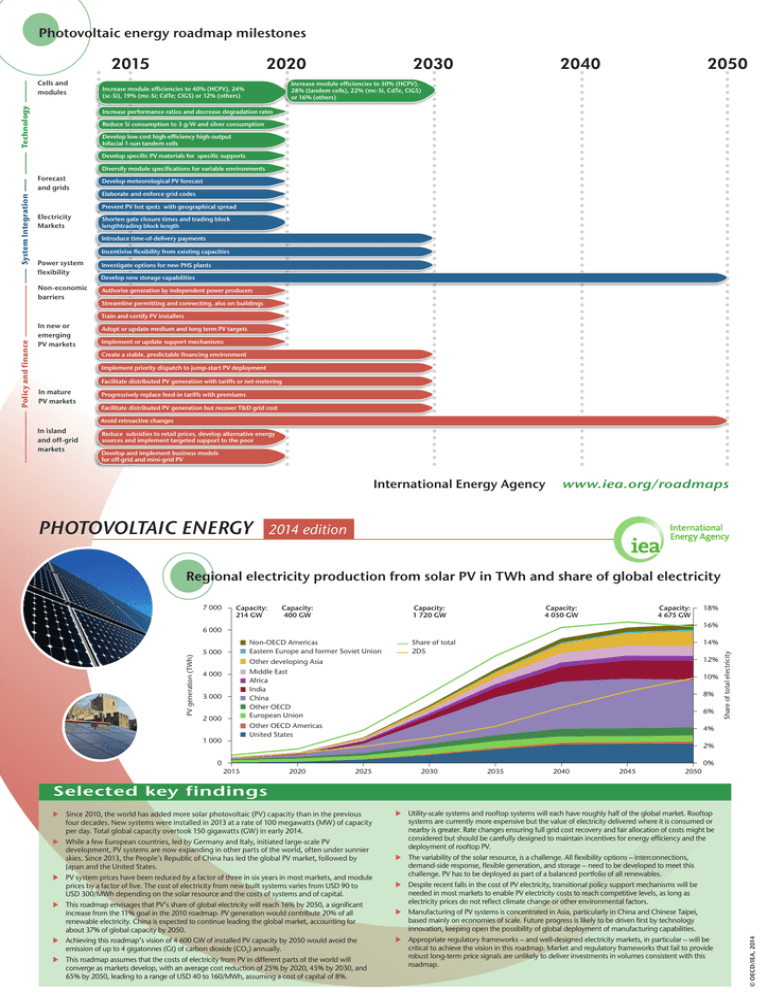
Photovoltaic energy roadmap milestones 2015 Technology Cells and modules 2020 2030 2040 2050 Increase module efficiencies to 50% (HCPV), 28% (tandem cells), 22% (mc-Si, CdTe, CIGS) or 16% (others) Increase module efficiencies to 40% (HCPV), 24% (sc-Si), 19% (mc-Si; CdTe; CIGS) or 12% (others) Increase performance ratios and decrease degradation rates Reduce Si consumption to 3 g/W and silver consumption Develop low-cost high-efficiency high-output bifacial 1-sun tandem cells Develop specific PV materials for specific supports Diversify module specifications for variable environments System Integration Forecast and grids Develop meteorological PV forecast Elaborate and enforce grid codes Prevent PV hot spots with geographical spread Electricity Markets Shorten gate closure times and trading block lengthtrading block length Introduce time-of-delivery payments Incentivise flexibility from existing capacities Power system flexibility Non-economic barriers Investigate options for new PHS plants Develop new storage capabilities Authorise generation by independent power producers Streamline permitting and connecting, also on buildings Adopt or update medium and long term PV targets Implement or update support mechanisms Create a stable, predictable financing environment Implement priority dispatch to jump-start PV deployment Facilitate distributed PV generation with tariffs or net-metering In mature PV markets Progressively replace feed-in tariffs with premiums Facilitate distributed PV generation but recover T&D grid cost Avoid retroactive changes In island and off-grid markets Reduce subsidies to retail prices, develop alternative energy sources and implement targeted support to the poor Develop and implement business models for off-grid and mini-grid PV International Energy Agency www.iea.org/roadmaps PHOTOVOLTAIC ENERGY 2014 edition Regional electricity production from solar PV in TWh and share of global electricity Capacity: 214 GW Capacity: 400 GW Capacity: 1 720 GW Capacity: 4 050 GW Capacity: 4 675 GW 18% 16% 6 000 Non-OECD Americas Eastern Europe and former Soviet Union 5 000 14% Share of total 2DS 12% Other developing Asia Middle East Africa India China Other OECD European Union 4 000 3 000 2 000 10% 8% 6% Other OECD Americas United States 1 000 Share of total electricity 7 000 PV generation (TWh) 4% 2% 0 0% 2015 2020 2025 2030 2035 2040 2045 2050 Selected key findings uuSince 2010, the world has added more solar photovoltaic (PV) capacity than in the previous four decades. New systems were installed in 2013 at a rate of 100 megawatts (MW) of capacity per day. Total global capacity overtook 150 gigawatts (GW) in early 2014. uuWhile a few European countries, led by Germany and Italy, initiated large-scale PV development, PV systems are now expanding in other parts of the world, often under sunnier skies. Since 2013, the People’s Republic of China has led the global PV market, followed by Japan and the United States. uuPV system prices have been reduced by a factor of three in six years in most markets, and module prices by a factor of five. The cost of electricity from new built systems varies from USD 90 to USD 300/MWh depending on the solar resource and the costs of systems and of capital. uuThis roadmap envisages that PV’s share of global electricity will reach 16% by 2050, a significant increase from the 11% goal in the 2010 roadmap. PV generation would contribute 20% of all renewable electricity. China is expected to continue leading the global market, accounting for about 37% of global capacity by 2050. uuAchieving this roadmap’s vision of 4 600 GW of installed PV capacity by 2050 would avoid the emission of up to 4 gigatonnes (Gt) of carbon dioxide (CO2) annually. uuThis roadmap assumes that the costs of electricity from PV in different parts of the world will converge as markets develop, with an average cost reduction of 25% by 2020, 45% by 2030, and 65% by 2050, leading to a range of USD 40 to 160/MWh, assuming a cost of capital of 8%. uuUtility-scale systems and rooftop systems will each have roughly half of the global market. Rooftop systems are currently more expensive but the value of electricity delivered where it is consumed or nearby is greater. Rate changes ensuring full grid cost recovery and fair allocation of costs might be considered but should be carefully designed to maintain incentives for energy efficiency and the deployment of rooftop PV. uuThe variability of the solar resource, is a challenge. All flexibility options – interconnections, demand-side response, flexible generation, and storage – need to be developed to meet this challenge. PV has to be deployed as part of a balanced portfolio of all renewables. uuDespite recent falls in the cost of PV electricity, transitional policy support mechanisms will be needed in most markets to enable PV electricity costs to reach competitive levels, as long as electricity prices do not reflect climate change or other environmental factors. uuManufacturing of PV systems is concentrated in Asia, particularly in China and Chinese Taipei, based mainly on economies of scale. Future progress is likely to be driven first by technology innovation, keeping open the possibility of global deployment of manufacturing capabilities. uuAppropriate regulatory frameworks – and well-designed electricity markets, in particular – will be critical to achieve the vision in this roadmap. Market and regulatory frameworks that fail to provide robust long-term price signals are unlikely to deliver investments in volumes consistent with this roadmap. © OECD/IEA, 2014 Policy and finance Train and certify PV installers In new or emerging PV markets c t iv e s Cost reductions, deployment and investments er gy 7 000 er En 250 sp e Levelised cost of electricity from new-built PV systems and generation by sectors Te c h n ol o gy P 6 000 200 150 4 000 TWh USD/MWh 5 000 3 000 100 2 000 50 1 000 0 0 2015 2020 Utility 2025 Industrial 2030 Commercial 2035 Residential Off-grid 2040 2045 Average LCOE (rooftop) 2050 Average LCOE (utility) Notes: Weighted average LCOE values rest on 8% real discount rates. Sectoral break-down of PV capacities are indicative only. KEY POINT: Electricity from PV systems will become progressively competitive on many more markets. Projections for LCOE for new-built rooftop PV systems to 2050 (USD/MWh) in the hi-Ren Scenario USD/MWh Cumulative investments in PV in hi-Ren (Billion USD 2012) 2011-30 2013 2020 2025 2030 2035 2040 2045 2050 Minimum 135 108 80 63 55 51 48 45 Average 201 157 121 102 96 91 82 Maximum 539 422 301 231 197 180 171 456 769 1 225 78 OECD Europe 268 241 509 159 Other OECD 323 356 679 China 894 1529 2 423 India 275 735 1 010 49 125 174 Other dev. Asia 160 695 855 Mid East Africa 266 483 749 20 76 96 2 711 5 010 7 721 Latin America (excluding Chile) 2013 2020 2025 2030 2035 2040 2045 2050 Minimum 119 96 71 56 48 45 42 40 Average 177 133 96 81 72 68 59 56 Maximum 318 250 180 139 119 109 104 97 Note: All LCOE calculations in both tables rest on 8% real discount rates as in ETP 2014. Actual LCOE might be lower with lower WACC. Selected key actions for the next 5 years uu Identify the cost structure of current projects. Implement specific actions to reduce excessive costs. 3.5 GtCO2/yr avoided procedures for providing permits. Latin America Eastern Europe and Former Soviet Union China India Middle East Other developing Asia Africa Other OECD North America United States OECD Asia Oceanic OECD Europe 4.0 with national energy strategies and national contributions to global climate change mitigation efforts. uu Address non-economic barriers. Develop streamlined Total CO2 abatement through PV in this roadmap over the 6DS, 2015-50 uu Set or update long-term targets for PV deployment, consistent and regulatory frameworks to drive investment. Other non-OECD CO2 emission reductions from solar photovoltaic energy 4.5 uu Support these targets with predictable market structures 2011-50 United States rojections for LCOE for new-built utility-scale PV plants P to 2050 (USD/MWh) in the hi-Ren Scenario USD/MWh 2031-50 uu In emerging PV markets: 3.0 2.5 2.0 1.5 1.0 zz Implement priority connection to the grid and priority dispatch of PV electricity. 0.5 zz Implement support schemes with fair remuneration for 0 investors but predictable decrease in the level of support. zz When parity with retail electricity prices is achieved in some market segments, provide incentives for distributed PV generation through net energy metering and/or tariffs for energy. uu In mature markets: 2015 2020 25 PV built PV systems and other renewables, and markets for ancillary services. zz Progressively reform rate structures to encourage generation and discourage consumption during peak times, ensuring the recovery of fixed costs of the transmission and distribution grids while preserving the incentives for efficiency and distributed PV. zz Avoid retroactive legislative changes. zz Work with financing circles and other interested parties to reduce financing costs for PV deployment, in particular involving private money and institutional investors. 2045 2050 2DS hi-Ren Power sector emissions (GtCO2) zz Design and implement investment markets for new- 2040 6DS zz Provide incentives for self-consumption and excess markets for better synchronisation of supply and demand. 2035 The contribution of solar PV to avoided CO2 emissions in this roadmap over the 6DS, 2015-50 electricity while ensuring fair remuneration of investment. zz Improve forecasts and reform energy-only electricity 2030 KEY POINT: China delivers one-half of the CO2 emission abatement through PV over the 6DS. zz Progressively increase short-term market exposure of PV generation at peak times through time-of-use electricity rates and time-of-delivery payments. 2025 20 15 10 5 0 2011 2015 2020 2025 2030 2035 2040 2045 2050 KEY POINT: In 2050, power sector CO2 emissions rise to 21.4 GtCO2/yr in the 6DS and fall to 1.2 GtCO2/yr in the 2DS hi-Ren. Solar PV provides 4 GtCO2/yr (20%) of the difference. www.iea.org/roadmaps c t iv e s Cost reductions, deployment and investments er gy 7 000 er En 250 sp e Levelised cost of electricity from new-built PV systems and generation by sectors Te c h n ol o gy P 6 000 200 150 4 000 TWh USD/MWh 5 000 3 000 100 2 000 50 1 000 0 0 2015 2020 Utility 2025 Industrial 2030 Commercial 2035 Residential Off-grid 2040 2045 Average LCOE (rooftop) 2050 Average LCOE (utility) Notes: Weighted average LCOE values rest on 8% real discount rates. Sectoral break-down of PV capacities are indicative only. KEY POINT: Electricity from PV systems will become progressively competitive on many more markets. Projections for LCOE for new-built rooftop PV systems to 2050 (USD/MWh) in the hi-Ren Scenario USD/MWh Cumulative investments in PV in hi-Ren (Billion USD 2012) 2011-30 2013 2020 2025 2030 2035 2040 2045 2050 Minimum 135 108 80 63 55 51 48 45 Average 201 157 121 102 96 91 82 Maximum 539 422 301 231 197 180 171 456 769 1 225 78 OECD Europe 268 241 509 159 Other OECD 323 356 679 China 894 1529 2 423 India 275 735 1 010 49 125 174 Other dev. Asia 160 695 855 Mid East Africa 266 483 749 20 76 96 2 711 5 010 7 721 Latin America (excluding Chile) 2013 2020 2025 2030 2035 2040 2045 2050 Minimum 119 96 71 56 48 45 42 40 Average 177 133 96 81 72 68 59 56 Maximum 318 250 180 139 119 109 104 97 Note: All LCOE calculations in both tables rest on 8% real discount rates as in ETP 2014. Actual LCOE might be lower with lower WACC. Selected key actions for the next 5 years uu Identify the cost structure of current projects. Implement specific actions to reduce excessive costs. 3.5 GtCO2/yr avoided procedures for providing permits. Latin America Eastern Europe and Former Soviet Union China India Middle East Other developing Asia Africa Other OECD North America United States OECD Asia Oceanic OECD Europe 4.0 with national energy strategies and national contributions to global climate change mitigation efforts. uu Address non-economic barriers. Develop streamlined Total CO2 abatement through PV in this roadmap over the 6DS, 2015-50 uu Set or update long-term targets for PV deployment, consistent and regulatory frameworks to drive investment. Other non-OECD CO2 emission reductions from solar photovoltaic energy 4.5 uu Support these targets with predictable market structures 2011-50 United States rojections for LCOE for new-built utility-scale PV plants P to 2050 (USD/MWh) in the hi-Ren Scenario USD/MWh 2031-50 uu In emerging PV markets: 3.0 2.5 2.0 1.5 1.0 zz Implement priority connection to the grid and priority dispatch of PV electricity. 0.5 zz Implement support schemes with fair remuneration for 0 investors but predictable decrease in the level of support. zz When parity with retail electricity prices is achieved in some market segments, provide incentives for distributed PV generation through net energy metering and/or tariffs for energy. uu In mature markets: 2015 2020 25 PV built PV systems and other renewables, and markets for ancillary services. zz Progressively reform rate structures to encourage generation and discourage consumption during peak times, ensuring the recovery of fixed costs of the transmission and distribution grids while preserving the incentives for efficiency and distributed PV. zz Avoid retroactive legislative changes. zz Work with financing circles and other interested parties to reduce financing costs for PV deployment, in particular involving private money and institutional investors. 2045 2050 2DS hi-Ren Power sector emissions (GtCO2) zz Design and implement investment markets for new- 2040 6DS zz Provide incentives for self-consumption and excess markets for better synchronisation of supply and demand. 2035 The contribution of solar PV to avoided CO2 emissions in this roadmap over the 6DS, 2015-50 electricity while ensuring fair remuneration of investment. zz Improve forecasts and reform energy-only electricity 2030 KEY POINT: China delivers one-half of the CO2 emission abatement through PV over the 6DS. zz Progressively increase short-term market exposure of PV generation at peak times through time-of-use electricity rates and time-of-delivery payments. 2025 20 15 10 5 0 2011 2015 2020 2025 2030 2035 2040 2045 2050 KEY POINT: In 2050, power sector CO2 emissions rise to 21.4 GtCO2/yr in the 6DS and fall to 1.2 GtCO2/yr in the 2DS hi-Ren. Solar PV provides 4 GtCO2/yr (20%) of the difference. www.iea.org/roadmaps Photovoltaic energy roadmap milestones 2015 Technology Cells and modules 2020 2030 2040 2050 Increase module efficiencies to 50% (HCPV), 28% (tandem cells), 22% (mc-Si, CdTe, CIGS) or 16% (others) Increase module efficiencies to 40% (HCPV), 24% (sc-Si), 19% (mc-Si; CdTe; CIGS) or 12% (others) Increase performance ratios and decrease degradation rates Reduce Si consumption to 3 g/W and silver consumption Develop low-cost high-efficiency high-output bifacial 1-sun tandem cells Develop specific PV materials for specific supports Diversify module specifications for variable environments System Integration Forecast and grids Develop meteorological PV forecast Elaborate and enforce grid codes Prevent PV hot spots with geographical spread Electricity Markets Shorten gate closure times and trading block lengthtrading block length Introduce time-of-delivery payments Incentivise flexibility from existing capacities Power system flexibility Non-economic barriers Investigate options for new PHS plants Develop new storage capabilities Authorise generation by independent power producers Streamline permitting and connecting, also on buildings Adopt or update medium and long term PV targets Implement or update support mechanisms Create a stable, predictable financing environment Implement priority dispatch to jump-start PV deployment Facilitate distributed PV generation with tariffs or net-metering In mature PV markets Progressively replace feed-in tariffs with premiums Facilitate distributed PV generation but recover T&D grid cost Avoid retroactive changes In island and off-grid markets Reduce subsidies to retail prices, develop alternative energy sources and implement targeted support to the poor Develop and implement business models for off-grid and mini-grid PV International Energy Agency www.iea.org/roadmaps PHOTOVOLTAIC ENERGY 2014 edition Regional electricity production from solar PV in TWh and share of global electricity Capacity: 214 GW Capacity: 400 GW Capacity: 1 720 GW Capacity: 4 050 GW Capacity: 4 675 GW 18% 16% 6 000 Non-OECD Americas Eastern Europe and former Soviet Union 5 000 14% Share of total 2DS 12% Other developing Asia Middle East Africa India China Other OECD European Union 4 000 3 000 2 000 10% 8% 6% Other OECD Americas United States 1 000 Share of total electricity 7 000 PV generation (TWh) 4% 2% 0 0% 2015 2020 2025 2030 2035 2040 2045 2050 Selected key findings uuSince 2010, the world has added more solar photovoltaic (PV) capacity than in the previous four decades. New systems were installed in 2013 at a rate of 100 megawatts (MW) of capacity per day. Total global capacity overtook 150 gigawatts (GW) in early 2014. uuWhile a few European countries, led by Germany and Italy, initiated large-scale PV development, PV systems are now expanding in other parts of the world, often under sunnier skies. Since 2013, the People’s Republic of China has led the global PV market, followed by Japan and the United States. uuPV system prices have been reduced by a factor of three in six years in most markets, and module prices by a factor of five. The cost of electricity from new built systems varies from USD 90 to USD 300/MWh depending on the solar resource and the costs of systems and of capital. uuThis roadmap envisages that PV’s share of global electricity will reach 16% by 2050, a significant increase from the 11% goal in the 2010 roadmap. PV generation would contribute 20% of all renewable electricity. China is expected to continue leading the global market, accounting for about 37% of global capacity by 2050. uuAchieving this roadmap’s vision of 4 600 GW of installed PV capacity by 2050 would avoid the emission of up to 4 gigatonnes (Gt) of carbon dioxide (CO2) annually. uuThis roadmap assumes that the costs of electricity from PV in different parts of the world will converge as markets develop, with an average cost reduction of 25% by 2020, 45% by 2030, and 65% by 2050, leading to a range of USD 40 to 160/MWh, assuming a cost of capital of 8%. uuUtility-scale systems and rooftop systems will each have roughly half of the global market. Rooftop systems are currently more expensive but the value of electricity delivered where it is consumed or nearby is greater. Rate changes ensuring full grid cost recovery and fair allocation of costs might be considered but should be carefully designed to maintain incentives for energy efficiency and the deployment of rooftop PV. uuThe variability of the solar resource, is a challenge. All flexibility options – interconnections, demand-side response, flexible generation, and storage – need to be developed to meet this challenge. PV has to be deployed as part of a balanced portfolio of all renewables. uuDespite recent falls in the cost of PV electricity, transitional policy support mechanisms will be needed in most markets to enable PV electricity costs to reach competitive levels, as long as electricity prices do not reflect climate change or other environmental factors. uuManufacturing of PV systems is concentrated in Asia, particularly in China and Chinese Taipei, based mainly on economies of scale. Future progress is likely to be driven first by technology innovation, keeping open the possibility of global deployment of manufacturing capabilities. uuAppropriate regulatory frameworks – and well-designed electricity markets, in particular – will be critical to achieve the vision in this roadmap. Market and regulatory frameworks that fail to provide robust long-term price signals are unlikely to deliver investments in volumes consistent with this roadmap. © OECD/IEA, 2014 Policy and finance Train and certify PV installers In new or emerging PV markets
